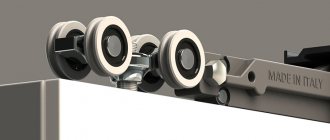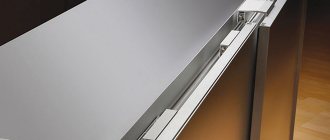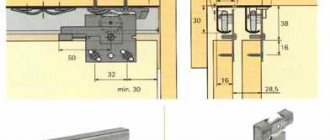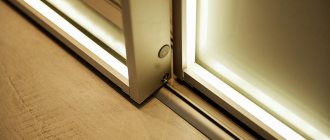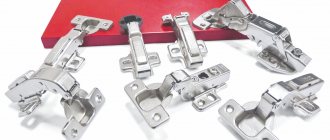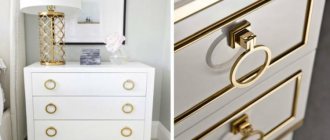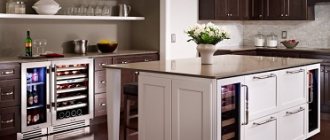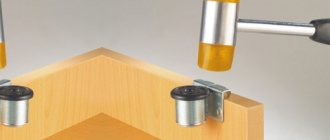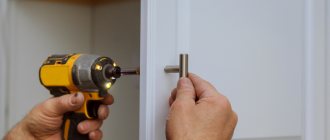Have you ever found that handles on cabinets are inconvenient? They get dirty and fall off over time, and it’s easy for a child to hit them. What if we offer you an alternative option - kitchen cabinets without a single handle? In this article we will take a closer look at one of the types of cabinet opening mechanisms - Tip-on, from the Austrian manufacturer Blum. How does the Tip-on mechanism work and how convenient is it in everyday life? Find out in our article!
Follow us on social media. networks
Main characteristics of furniture pushers, nuances of choice
Most stores that sell furniture fittings offer several types of pushers, stops, latches and other elements of pressure opening systems from different manufacturers. The price range may also vary, as may some technical specifications.
When choosing, pay attention to the following points:
- Pusher stroke. It can vary between 10-45 mm and is adjustable. If ordinary furniture hinges or hinges with closers are used (for smooth closing), then it is better to install pushers with a stroke of 40-45 mm on the facades. If you decide to use furniture hinges with return springs, then the stroke may be less, as in the case of springless hinges. But it is definitely better to choose magnetic pushers (that is, with a magnetic tip).
- Spring/gas lift force. There are standard and enhanced options. For heavy doors and large drawers, it is better to purchase reinforced pushers. Or put two on the façade (which is not always justified or acceptable).
- Mounting method, overhead or mortise . It all depends on personal preferences and installation nuances. For internal facades, of course, they purchase overhead pushers, since cutting into the end is impossible. To install mortise components, it is necessary to drill a hole in the end with a diameter of 10 mm and a depth corresponding to the length of the pusher capsule.
- Tip type. The pusher can be equipped with a magnetic tip to additionally hold the sash. Or rubber to ensure softer and quieter closing. Magnetic pushers are uniquely selected for return loops, as described above. And also to folding facades equipped with additional lifting mechanisms.
- Capsule color. As a rule, the range is limited to neutral white or gray tones. There are models on sale with capsules and adapters in black, beige, metallic or stainless steel.
Installing the synchronization shaft on TIP-ON.
The shaft with the installed gear has telescopic properties, which allows it to be easily installed on the TIP-ON. If you take the synchronization gears (ends of the shaft) and try to squeeze the shaft (as if compressed along the length), it will decrease due to the springing of the gears at the ends of the shaft. This nuance will facilitate further understanding of what is happening.
Extend the telescopic part of the guide. Place one end of the shaft under the TIP-ON and insert it into the groove on the Tipon until it locks. Then grab the opposite gear (end of the wad) and squeeze, the size will decrease and allow the opposite gear to be inserted into the slot of the second Tipon (last picture). The installation is complete, you can begin installing the drawer on the Tandem guides. The installation of the drawer is carried out in the same way as on the Tandem guides. See Installing a drawer on Tandem slides.
Simple and inexpensive pusher with single and double magnets
Even before products from such brands as Hettich, Blum, Boyard, etc. appeared on the Russian market, furniture makers successfully used a simple magnetic pusher for glass doors. It can be purchased complete with a single or double magnet and special metal pads.
The mechanism is also suitable for installation on ordinary, solid cabinet doors. True, for the magnet to also “work”, you will have to either unbend and drill out the metal plates included in the kit, or adapt something else. An alternative is to glue or screw in a small round washer using a self-tapping screw.
Magnetic pusher for Boyard cabinet door
Overhead magnetic pusher for cabinet doors in a stainless steel capsule. The magnet also plays a “holding” role and protects against sudden full opening of the sash. The manufacturer (Boyard) recommends using this type of magnetic pushers in combination with furniture return hinges.
Hettich Push-to-open system
The Push-to-open series of systems for opening furniture facades by the famous German manufacturer Hettich provides absolutely all options for pusher pushers:
- Push to open Magnet. Standard magnetic pusher with self-adhesive striker included. Additionally, you can purchase an adapter for surface mounting and a strike plate with a coupling if the adhesive base is not acceptable for some reason. Recommended for use in combination with hinges of the same series. Designed for small doors, 300-600 mm wide and 300-900 mm high.
- Push to open Magnet XL . Unlike the previous version, the reinforced magnetic pusher is equipped with a stepless gap adjustment system (2.3-5.3 mm). Can be used for installation on doors 300-600 mm wide and 900-1600 mm high.
- Push to open Pin . An interesting model of the stop-latch “in reverse”, when the applied capsule is installed on the side of the body, and the pusher itself is mounted on the inside of the facade. Without magnet. Recommended for use in combination with Push to open hinges. Designed for a substantial weight of facades, 300-600 mm in width and up to 300-2400 mm in length.
- Push to open Universal maxi. A universal pusher without a magnet, which can be installed on facades with any furniture hinges.
Tip-on Blum push release system
The Tip-on series from the Austrian manufacturer Blum offers two types of magnetic pushers:
- Standard. The stroke length of the magnetic pusher is 18 mm. For installation on small and medium sized doors (height up to 1300 mm)
- Long. The stroke length of the magnetic pusher is 38 mm. Reinforced option for larger doors and drawers.
The Blum Tip-on series magnetic pushers are available for surface-mounted and flush-mount installation (adapter for surface-mounted installation is sold separately). Recommended for installation complete with springless hinges.
Installing the TIP-ON gasket on Tandem guides.
Take the spacers (two small rectangular things with a hole) and install them on the tandem guide pin
This applies to both full and partial extension guides.
The spacers are designed to create a small protrusion (about 3 mm) of the facade relative to the plane of the body. This is necessary for the Tipon to work. What a small thing - and what an important one!
DO NOT TRY TO PUT TIP-ON ON THE RAILS WITH BLUMOTION (CLOSER) - NOTHING WILL WORK!
Magnetic latches series Push Magnetic Makmart
The peculiarity of the Push Magnetic series is its modularity. You can only purchase a magnetic pusher with a metal self-adhesive overlay on the facade for insertion into the end of the body. If you require an overhead version of the pusher, then purchase an adapter with fastening with screws or an adhesive base. The metal striker with adhesive is convenient for installation on facades made of aluminum frames. There is a variant of the strike plate on the “nail”.
How does Tip-On work?
Tip-On is a mechanical system for opening facades with one touch. The principle of operation is simple, like everything ingenious. You press lightly on the drawer and the door opens slightly. To close the cabinet, you need to return it to its original position and, again, lightly press the front. Watch the video - it clearly shows how this mechanism works:
Check out our work
The mechanism itself is small, literally the size of a ballpoint pen. It is mounted in a pre-drilled hole in the end of the housing or using holders inside the cabinet in such a way that only the pusher is visible.
Magnetic latches for opening by pressing the Push-latch series Makmart
The Push-Latch series includes all types of push mechanisms. With shock absorber (pusher stroke 40 mm) and magnet (pusher stroke 16 mm), with mortise and overlay installation, with appropriate fastening. There are several options for counter strips for the magnetic pusher, including under glass facades and aluminum frames.
How to properly install pushers for facades
Before installation, you should clarify which hinges the manufacturer recommends using to mount the facade itself.
- Some pushers require installation of the façade on springless hinges. In this case, the door is fixed in the closed state due to the magnetic tip and the metal striker.
- Furniture hinges with a return spring can “work” without a pusher at all. The ejection mechanism itself is already built into the hinge arm. The role of the latch stop itself is to soften the harshness of movement and fix the door.
- Some pushers allow the installation of furniture hinges with closers. This is a plus, since the ejection and soft closing mechanisms themselves are radically opposite and very rarely “get along” together.
The pusher capsule itself is installed in the place of intended pressing. For drawers - as close as possible. If the drawers are located one under the other, as in a chest of drawers, then it is better to provide special strips in the design of the box. Pressing on the sides of the front to push out the drawer is not always convenient.
Usually, the pusher comes with instructions with a detailed installation diagram for overhead and mortise installation.
Please note that the pusher itself can only operate if there is a gap between the facade and the furniture body. That is, the cabinet door or drawer should not be tightly adjacent to the box. Typically the gap is 2-3 mm. Four-hinged furniture hinges allow you to “pull out” the façade using an adjusting screw. But the drawer guides must be screwed in immediately, not as deeply as in the standard case (without any indentation from the edge).
The ability to adjust the length makes it easier to install the façade pushers. It allows you to set the optimal gap size by simply turning the pusher itself.
If the pusher has a length adjustment, you will not have to adjust the gap for the push mechanism to work correctly by adjusting the hinges and drawer guides. And installation is much easier.
The system for opening furniture facades by pressing is one of the ways to make doors without handles. You might be interested in learning how else you can make cabinets without handles.
Tip-On – a good marketing ploy or convenient functionality?
We now know the operating principle and main characteristics of the Tip-On mechanism. It remains to be seen how convenient this is in everyday life.
Tip-On mechanisms from Blum are considered the highest quality, and therefore they are purchased much more often. We often ask our customers for feedback on how comfortable they are with the furniture we produce. The same goes for fittings.
Most customers are more than satisfied with Blum fittings and mechanisms. For example, it is very convenient for girls in the kitchen to open a drawer with a trash can if their hands are dirty or wet. When your hands are busy with kitchen utensils, the “little finger” is enough to open the door.
On review forums, people write that due to the fact that they constantly press on the cabinet with dirty hands, the facades become stained over time. So when choosing a coating for kitchen facades, it is better to choose a non-staining one - enamel or gloss, they are easy to clean
And someone notes another minor drawback - the ease and convenience of opening applies only to the lower level of cabinets or drawers. Hinged doors with Tip-On on upper facades may seem awkward to close for some people. But it turns out to be more convenient to open cabinets that are located higher with the help of Tip-on than with handles. So here it’s worth thinking about the door closers; perhaps the whole reason for the discomfort is that the doors do not close on their own.
